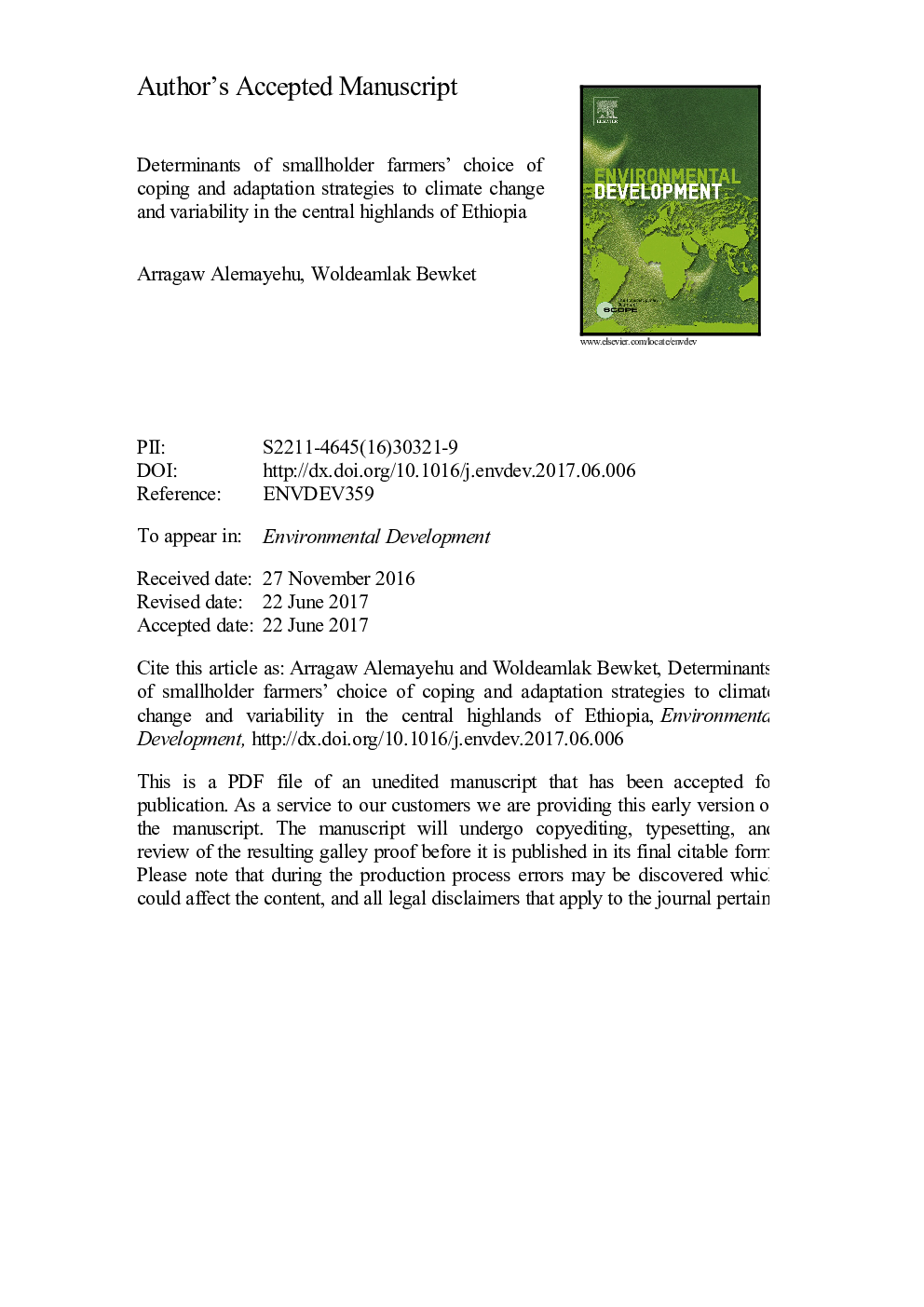| کد مقاله | کد نشریه | سال انتشار | مقاله انگلیسی | نسخه تمام متن |
|---|---|---|---|---|
| 8848311 | 1618077 | 2017 | 17 صفحه PDF | دانلود رایگان |
عنوان انگلیسی مقاله ISI
Determinants of smallholder farmers' choice of coping and adaptation strategies to climate change and variability in the central highlands of Ethiopia
ترجمه فارسی عنوان
تعیین عوامل انتخاب کشاورزان خرده فروشی از راه حل های مقابله و سازگاری با تغییرات آب و هوایی و تنوع در مناطق مرکزی اتیوپی
دانلود مقاله + سفارش ترجمه
دانلود مقاله ISI انگلیسی
رایگان برای ایرانیان
کلمات کلیدی
تغییر آب و هوا، عوامل موثر بر مقابله و سازگاری، رگرسیون لجستیک، شمال شوی، اتیوپی،
ترجمه چکیده
این مطالعه تجزیه و تحلیل عوامل تعیین کننده انتخاب استراتژی های مقابله ای و سازگاری میان کشاورزان خرده پا را به تغییرات آب و هوایی و تنوع در مناطق مرکزی اتیوپی ارائه می دهد. تمایز بین مقابله و انطباق، به عنوان پاسخ کوتاه مدت به شوک ها و پاسخ های طولانی مدت به عوامل استرس زا بود. مدل رگرسیون لجستیک دوتایی براساس یک نظرسنجی از 200 کشاورز استفاده شد. خصوصیات اجتماعی-دموگرافیک، اقتصادی، بیوفیزیکی، و سازمانی و زیربنایی تنظیمات مطالعه و خانواده های نمونه در نظر گرفته شده است تا عوامل تعیین کننده انتخاب انتخاب کشاورزان از مقابله و استراتژی های سازگاری را شناسایی کنند. این بر این حقیقت استوار است که شناخت عوامل تعیینکننده انتخاب انتخابگران برای مقابله و استراتژیهای انطباق، مفید است برای طراحی مداخلات انطباق قابل توجه در محل. نتایج نشان داد که عوامل مؤثر بر انتخاب راهکارهای سازگاری شامل وضعیت باروری درک شده، درک زمینه امنیت زمینی، دسترسی به خدمات پس زمینه و سنی سران خانوار می باشد. برای انتخاب گزینه های مقابله ای، منطقه زراعی و زراعی، دسترسی به بازار، گسترش مزرعه دار به کشاورز، اندازه زمین دارایی، دسترسی به اطلاعات در مورد تغییرات آب و هوایی، میزان بارش و سطح تحصیلات سران خانوار، تعیین کننده های مهمی بودند. منطقه زراعی محیطی تاثیر منفی بر استفاده از فروش دام به عنوان استراتژی مقابله ای داشت، در حالی که متغیرهای دیگر تاثیر مثبتی بر انتخاب کشاورزان از استراتژی مقابله و سازگاری داشتند. درآمد مزرعه، مشارکت جامعه، مالکیت دام و درجه حرارت از سوی دیگر تأثیر قابل توجهی در انتخاب راهکارهای مقابله و سازگاری با تغییرات اقلیمی نداشت. برنامه ریزی انطباق برای محل مطالعه باید در نظر گرفتن تاثیر بالقوه این عوامل تعیین کننده را در نظر بگیریم.
موضوعات مرتبط
علوم زیستی و بیوفناوری
علوم محیط زیست
بوم شناسی
چکیده انگلیسی
This study presents analysis of determinants of smallholder farmers' choice of coping and adaptation strategies to climate change and variability in the central highlands of Ethiopia. A distinction was made between coping and adaptation, as short-term responses to shocks and long-term responses to stressors, respectively. Binary logistic regression modeling was used based on a survey of 200 farmers. Socio-demographic, economic, biophysical, and institutional and infrastructural characteristics of the study setting and sample households were considered to identify key determinants of farmers' choice of coping and adaptation strategies. This is premised on the fact that understanding significant determinants of farmers' choice of coping and adaptation strategies is useful to design impactful adaptation interventions in the locality. The results showed that the significant factors affecting choice of adaptation strategies include perceived soil fertility status, perception of land tenure security, access to extension service, and ages of household heads. For the choice of coping options, agroecological zone, access to markets, farmer-to-farmer extension, landholding size, access to information on climate change, rainfall amount, and educational level of household heads were the significant determinants. Agroecological zone had negative influence to use selling livestock as coping strategy while the other variables had positive influences on farmers' choice of coping and adaptation strategies. Off-farm income, community participation, ownership of livestock and temperature on the other hand had no significant influence on the choice of coping and adaptation strategies to climate change. Adaptation planning for the study locality should take into account the potential influence of these determinant factors into account.
ناشر
Database: Elsevier - ScienceDirect (ساینس دایرکت)
Journal: Environmental Development - Volume 24, December 2017, Pages 77-85
Journal: Environmental Development - Volume 24, December 2017, Pages 77-85
نویسندگان
Arragaw Alemayehu, Woldeamlak Bewket,
